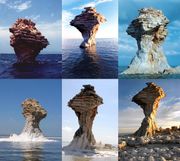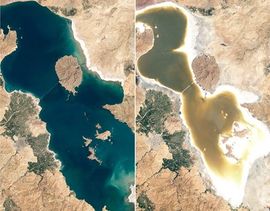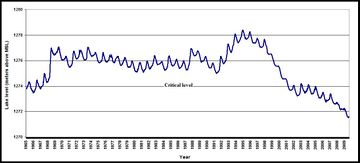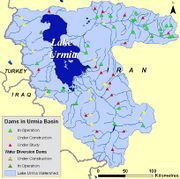Urmia Lake: The Need for Water Diplomacy
| Geolocation: | 37° 45' 36.3222", 45° 28' 53.081" |
|---|---|
| Total Population | 4.64,600,000 millionmillion |
| Total Area | 51,87651,876 km² 20,029.324 mi² km2 |
| Climate Descriptors | Humid mid-latitude (Köppen C-type), Continental (Köppen D-type), Dry-summer |
| Predominent Land Use Descriptors | agricultural- cropland and pasture, agricultural- confined livestock operations |
| Important Uses of Water | Agriculture or Irrigation, Domestic/Urban Supply, Industry - consumptive use, Industry - non-consumptive use, Other Ecological Services |
Contents
Summary
Natural, Historic, Economic, Regional, and Political Framework
Urmia Lake in Northwestern Iran is the 20th largest lake and prior to September 2010 was the second largest hypersaline lake in the world (Figure 1). The lake is also the largest inland body of salt water in the Middle East area with an area that varied from 2,000 to 2,300 square mi (5,200 to 6,000 square km). It is about 87 mi (140 km) long and 25–35 mi (40–55 km) wide, with a maximum depth of 53 ft (16 m) therefore it is classified as a shallow lake, with high evaporation, (Sorgeloos 1987 and Delju et al. 2013). The annual average of basin temperature is 11 ˚C around the lake, and 2.5 ˚C in mountain areas . (Razmara, 2013). The average temperature and rainfall as measured at Urmia station is provided in Figure 5.
The lake basin is one of the most influential and valuable aquatic ecosystems in the country. Some 1500 species of vascular plants, including unique Artemia sp., are located in the wetlands of the lake which represent 15% of the total number of flora species found in the country. Because of its unique natural and ecological features, the lake and its surrounding wetlands have been designated as a National Park, a Ramsar Site and a UNESCO Biosphere Reserve (CIWP 2008).
More than seven million people are living in two neighboring provinces around the lake, and agriculture, horticulture, animal husbandry, handicraft making, apiculture, mining, business, and industry play a major role in the region (Delju et al 2013). The basin itself has include a population of about 4.6 million in itself. The lake basin, as a socio-ecological region, faced extreme water shortages in the recent years due to water overuse and climate change (Alipour 2006, Zarghami 2011). Because of the intense agricultural development and rapid urbanization, the groundwater level in some parts of the basin has decreased by up to 16 meters. The water level of the lake and area are now below the critical level (Figure 2). The lake requires a minimum inflow of 3.1 billion cubic meters per year to compensate for evaporation, otherwise the wind-blown salty dusts will threaten the health of people in the area.
The normal total catchment area of the lake was about 51,876 km2,which comprised 3.15% of the entire country and included 7 % of the total surface water in Iran (Urmia Lake Basin Integrated Water Resources Management Home Page).
The Lake Ecosystem
Lake Urmia provides habitat for more than 211 species of birds, such as flamingos, pelicans, spoonbills and gulls; 41 species of reptiles; 7 species of amphibians and 27 species of mammals inhabit the lake (Figure 8). Artemia (brine shrimp) lives in Lake Urmia and provides an important food source for migrating water birds (http://www.oxu.ca/lake/, accessed 12-06-2014).
The Zarrinehrud river is one of the main inflows to the lake. The Zarrinehrud River basin, located in southeast of the lake, has an area of about 11578 km2. The Zarrinehrud River originates in the Chehelcheshmeh Mountains between Saghez and Bukan and flows toward the Urmia Lake with length of 240 km long and an average annual discharge of about 1971 MCM. The Martyr Kazemi dam, which is also called the Zarrinehrud dam, was built on this river in 1970. It is located in West Azerbaijan, 35 km from Bukan. It provides water for the Mianduab plain, parts of the Bonab, and Malekan plains. The gross agricultural area of the basin is 64640 ha, of which 58171 ha is irrigable. These agricultural areas are very crucial for the life of the people in the region (Safari, et al. 2014). In addition to agricultural consumption, the Zarrinehrud River supplies more than 40% of the domestic water demand of the city of Tabriz. The maximum annual water transmission is designed to be 157 MCM/Y. The project’s goals are the refinement and transmission of 5 m3/s, mainly for domestic consumption in the cities of Tabriz, Mianduab, Bonab, and Azarshahr and to provide the required water for a petrochemical company, a refinery, the Tabriz thermal power plant, the Sahand power plant and the Martyr Salimi industrial park. Thus because of the limited water supply there is a conflict between the water users which the Iran Water Resources Management Company (IRWRMC) could control with appropriate price strategy.
Agriculture, Irrigation and Development in the Lake Urmia Basin
In view of the dependence of agricultural operations on runoff and ground water resources, 35 dams have been built on 21 rivers flowing to the lake. All rivers in the basin flow towards Urmia Lake. As a result, the combined effect of these dams along with high exploitation of ground water intensified by recent drought cycles has brought the lake to a critical situation. The lake level variation equaled to 3 m from August 1998 to August 2001, approximately; however, the receding level has gained more rapid pace since early 2010. The level of variation equaled to 6.8 m from January 1992 to August 2010 (Figure 6). As a result, this has rapidly changed shorelines and caused a disappearance of the existing landscape in the region. Persistence of this phenomenon plus other subsidiary impacts of climate change such as rapid reduction in ground water resources, loss of land productivity, degradation of agricultural lands, soil erosion, and salinization associated with water scarcity seem to be strong enough to trigger a possible future migration and human displacement of a vulnerable rural population from dry lands to other areas in the country. (Delju et al 2013)
In addition to mentioned problems, a causeway was also constructed to facilitate transportation between cities on the east and west sides of the lake. Because the majority of water flow to the lake originates from the south, the causeway has changed the circulation pattern, resulting in many environmental problems. Results of investigations show that in early 2003, climatic conditions and the causeway caused the salinity of the lake to increase up to 250 ppt in the southern part; while, it exceeded 280 ppt in the northern part (Zarghami, 2011) Artemia, a key link in the lake ecosystem’s food chain, could tolerate salinity as high as 300 mg/l. However, its population growth is extremely low at high salinity; furthermore, most of its physiological activities will stop (Agh 2006). With continued salinity increase, the diminshed Artemia populations cannot recover fully, especially in the northern part, (Abatzopoulos et al. 2006, Abbaspour and Nazaridost 2007).
Because of spatio-temporal discrepancy among natural flows and also the water demands numerous dams are built on the streams running to the lake. These dams and their locations are depicted in Figure 9. These dams are primarily for water storage for irrigation purposes.
Vekerdy (2009) emphasizes that "Due to the intensive irrigation and pumping, the surface and the groundwater resources are overused around the lake. Less and less water is available for the compensation of evaporation in the Urmia Lake, so the shoreline retreats, leaving salt flats behind. This land cannot be used for agricultural production, but it can be a source of wind-blown salty dust, which precipitates on the agricultural lands and makes production impossible. The dust might cause severe respiratory diseases among the population in the basin, as was experienced in one of the largest environmental disasters of this kind, around the Aral Sea."
Tourism

The lake has historically had scenic value, exemplified in its designication as a National Park. The desiccation of the lake will impact the number of visitors Reduced tourism has both economic and educational disadvantages.
Groundwater
Influence, Leadership and Power
The government of the Islamic Republic of Iran established the Urmia Lake Restoration Program (ULRP) in 2013. After several meetings, this program produced a set of guidelines, including 19 potential solutions for the lake. One of these solutions was to rent the lands of the Zarrinehrud River (which provides roughly 40% of all inflow to the lake) from farmers who did not harvest during winter seasons of the preceding three years. However, this solution was rejected by members of the local parliament who claimed the plan would negatively impact employment and waste funding on farmers, who do not possess effective tools to invest. Another solution mentioned by the ULRP was reallocation of water among the lake's three neighboring provinces. When applied, however, this approach resulted in each province making greater demands, and ultimately claiming more water. Consensus building among these stakeholders is vital to the survival of the lake. As the ULRP lacks the authority to enforce compliance among local provinces, agricultural and water ministries, and parliamentary units, the introduction of a "water parliament" is one solution in which all formal stakeholders can receive equitable consideration toward the development of a successful mandatory policy.
Issues and Stakeholders
Agricultural Lands: Importance of agricultural productivity and negative impacts from agricultural water use
NSPD: Water Quantity, Ecosystems, Assets
Stakeholder Types: Federated state/territorial/provincial government, Sovereign state/national/federal government, Local Government, Development/humanitarian interest, Environmental interest, Community or organized citizens
Tourism – as lake levels drop, the scenic and recreational value of the lake also decreases
NSPD: Ecosystems, Assets, Values and Norms
Stakeholder Types: Local Government, Environmental interest, Cultural Interest
Link between the water level in Lake Urmia, public health, and environmental health problems
NSPD: Water Quality, Ecosystems, Assets
Stakeholder Types: Local Government, Environmental interest, Community or organized citizens
Industrial pollutants and heavy metals, and the use of large quantities of pesticides to control parasites and weeds have accumulated in groundwater and surface water that inflow to the lake. Therefore, Urmia Lake's water contains Cl-, Na+, Ca2+, Mg2+, Hco3-, K+, Li, So42+, and F (Abazopoulos et al., 2006). In recent years, half of the lake has changed to saline area that contains these toxic materials. If winds blow from this polluted area near the lake to other places in the region, the consequence would be a huge change in the cycle of region's ecosystem also in people's life. For example, in the cities, by breathing this toxic air, people will have many illnesses such as breathing problems.
The lake's water salinity increased significantly and supersaturated with brine, and this will continue in the future, too. The number of visiting birds has been reduced significantly. The lake is a significant habitat for Artemia (brine shrimp), which are valued food source for migratory birds, including flamingos. Increasing salinity threatens the various species
Analysis, Synthesis, and Insight
Individuals may add their own Analysis, Synthesis, and Insight (ASI) to a case. ASI sub-articles are protected, so that each contributor retains authorship and control of their own content. Edit the case to add your own ASI.
Learn moreNo ASI articles have been added yet for this case
Key Questions
Power and Politics: How can government be dis/incentivized to offer an inclusive planning process?
Urmia Lake Restoration program initiated Iran Department of Environment (DOE) has prepared a 10-year plan to restore the Lake Urmia. The plan includes different solutions with a 10 year horizon will maintain the lakes condition. In addition to this, the UNDP (United Nations Development Programme) is also in collaboration with DOE have concluded the following solution to survive the lake (UNDP and DOE 2013):
Urgent Actions (to be implemented within 1-2 years)
- Strengthen the institutional structure
- Update the Integrated Management Plan
- Establish a Lake Urmia Sustainability Fund
- Reduce agricultural water use
- Mobilize a public campaign to conserve water
- Ecological restoration of (part of) the lake – “embayment”
- Implement health-protection measures (especially related to salt/dust storms)
- Develop a monitoring system on the condition of the basin and the lake
Recommended medium-term actions
- Prepare a long-term development vision for the Basin
- Continue with water conservation measures
- Do not prioritize certain supply-side measures
- Optimize the water allocation system
Integration across Sectors: How can consultation and cooperation among stakeholders and development partners be better facilitated/managed/fostered?
The government of Islamic Republic of Iran established the Urmia Lake Restoration Program (ULRP) in 2013. This program is under auspices of the President and then has more power than of the former program initiated by DOE. After several meetings, this program produced a set of guidelines, including 19 potential solutions for the lake. One of these solutions was to rent the lands of the Zarrinehrud River (which provides roughly 40% of all inflow to the lake) from farmers who did not harvest during winter seasons of the preceding three years. However, this solution was rejected by members of the local parliament who claimed the plan would negatively impact employment and waste funding on farmers, who do not possess effective tools to invest. Another solution mentioned by the ULRP was reallocation of water among the lake's three neighboring provinces. When applied, however, this approach resulted in each province making greater demands, and ultimately claiming more water.
Consensus building among these stakeholders is vital to the survival of the lake. As the ULRP lacks the authority to enforce compliance among local provinces, agricultural and water ministries, and parliamentary units, the introduction of a "water parliament" is one solution in which all formal stakeholders can receive equitable consideration toward the development of a successful mandatory policy.
External Links
- [ ] — * Abatzopoulos TJ, Agh N, Van Stappen G, Razavi Rouhani SM, Sorgeloos P. 2006. Artemia sites in Iran. Journal of the Marine Biological Association of the United Kingdom. 86: 299–307.
- Abbaspour M, Nazaridoust A. 2007. Determination of environmental water requirements of Lake Urmia, Iran: an ecological approach. International Journal of Environmental Studies, 64(2): 161-169.
- Agh N. 2006. Resource assessment of Artemia in Lake Urmia, Urmia (Iran): Artemia and Aquatic Animals Research Institute.
- Alipour S. 2006. Hydrogeochemistry of seasonal variation of Urmia Salt Lake, Iran, Saline Systems, 2(9): doi:10.1186/1746-1448-2-9.
- Bhatti MA. 1995. System analysis techniques in water resource management. Proc., WRM’95, Isfahan University of Technology, Iran
- CIWP: Conservation of Iranian Wetlands Project. 2008. Integrated management plan for Lake Uromiyeh, Tehran: Department of Environment.
- CIWP, 2014. Conservation of Iranian Wetlands Project , Asian Wetland Symposium / Ramsar Pre-COP12 Asia Regional Meeting, 3-7 November 2014, Siem Reap, Cambodia.
- Delju, A. H. ., Ceylan, A., Piguet, E., & Rebetez, M. . (2013). Observed climate variability and change in Urmia Lake Basin, Iran. Theor Appl Climatol, 111(1-2), 285-296.
- Elshorbagy A, Ormsbee, L. 2006. Object-oriented modeling approach to surface water quality management. Environmental Modeling and Software, 21(5): 689-698
- Hobbi, H, 2014, http://www.panoramio.com/photo/91614819
- Lewis, G. (2013) http://www.ir.undp.org/content/iran/en/home/presscenter/articles/2013/10/28/the-looming-death-of-lake-uromiyeh-and-what-it-means-for-iran-.html
- Rasuly AA (2005) Modelling of Urmia Lake coastal changes by applying an integrated RS/GIS approach, Tabriz University. GIS & RS Center, Tabriz
- Razmara, P., Massah Bavani, A. R., Motiee, H., Torabi, S., and Lotfi, S. 2013. Investigating uncertainty of climate change effect on entering runoff to Urmia Lake Iran, Hydrol. Earth Syst. Sci. Discuss., 10, 2183-2214.
- Safari, N., Zarghami, M. and Szidarovszky, F. (2014) Nash bargaining and leader-follower models in water allocation: Application to the Zarrinehrud River basin, Iran, Applied Mathematical Modelling, 38, 1959-1968.
- Semenov MA, Brooks RJ. 1999. Spatial interpolation of the LARS-WG stochastic weather generator in Great Britain, Climate Research, 11: 137–148.
- Sima, S., Tajrishy, M. 2013. Using satellite data to extract volume-area-elevation relationships for Urmia Lake, Iran. Journal of Great Lakes Research, 39(1): 90-99.
- Simonovic SP. 2009. Managing Water Resources, Methods and Tools for a Systems Approach, Paris: UNESCO Publishing / Earthscan.
- Sorgeloos P (1987) Brine shrimp Artemia in coastal saltworks: hydrobiological key to improved salt production and inexpensive source of food for vertically integrated aquaculture. Proc. International Meeting on "Saltworks Conversion for Aquaculture", Trapani, Italy, 9–11 May 1986, pp 133–141
- UNDP and DOE, International Technical Round Table on Drying Wetlands 16-18 March 2014, Tehran, IR Iran
- Vekerdy Z. 2009. http://www.waterfoodecosystems.nl/content.php?page=1920. Accessed 14 No 2010.
- Zarghami M. (2010). Urban water management using fuzzy-probabilistic multi-objective programming with dynamic efficiency, Water Resources Management 24(15):4491–4504.
- Zarghami M, Abdi A, Babaeian I, Hassanzadeh Y, and Kanani R. 2011. Impacts of climate change on runoffs in East Azerbaijan, Iran, Global and Planetary Change, 78(3-4): 137-146.
- Zarghami M. 2011. Effective watershed management; Case study of Urmia Lake, Iran, Lake and Reservoir Management, 27(1): 87-94.









